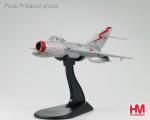Hobby Master Archive
Air Power Jets 1/72
MiG-15
The MiG-15 (NATO name Fagot) was designed from information and technology gathered from captured WWII Germans. The main features of the Mig-15 were its simplicity and swept wings. The MiG-15bis was an improved single-seat fighter with better cannon, fuel capacity, avionics and a Klimov turbojet engine developed using an unlicensed Rolls-Royce Nene engine. All this was put in a strengthened airframe. The Allies were completely surprised when the Mig-15 arrived in Korea and quickly brought about the development of the F-86 Sabre.
The Mikoyan-Gurevich MiG-15 with its swept wings first achieved fame during the Korean War. When it first arrived it could out fly anything the Allies had in the sky. It wasn’t long before the Allies developed the F-86 Sabre to counter this new fighter. There have been over 12,000 Mig-15s manufactured by the USSR with at least another 6,000 built under license by other countries. The new highly advanced Mig-17 was developed using the Mig-15 as the basis for its design.
In 1948 the USSR developed a jet fighter with 35 degree swept-wings and named it the l-310. The plane performed poorly because of the under powered engine. At this time Britain donated a new far superior Rolls-Royce Nene engine to Soviets who quickly copied the engine and renamed the Klimov RD-45. The l-310 with the new engine was more powerful engine took to the sky as the MiG-15bis.
The USSR had successfully copied the Rolls-Royce Nene engine and used it in the MiG-15 then set out to make improvements. Klimov developed the VK-1 engine that used larger components such as the combustion chamber the turbine blades and tail pipe. All this had to be accomplished so the new engine would fit into the same space that the Nene used. The MiG-15bis (NATO code name - Fagot B) (bis - second) had a reconnaissance version labeled the MiG-15bisR. On this variant one of the 23 millimeter cannons was replaced with a single vertically-mounted camera and normally carried 600 liter long-range fuel tanks. The MiG-15bis used a more powerful engine and hydraulically boosted ailerons. There were a total of 364 MiG-15bisR built. The MiG-15bis was the main variant built.


















